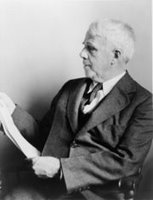
Rhyme scheme is the exact correspondence of rhyming sounds at the end of each line of poetry, identified by the first end rhyme represented by a lower case "a," the next variation by a "b," the third variation by a "c," and so on.
Below is an illustration of a common rhyme scheme for closed form poems written in quatrains (four-line stanzas).
(To see the web resource from which this illustration is drawn, go to http://www.millikin.edu/aci/crow/basics/frost3.html
"Stopping by Woods on a Snowy Evening"
By Robert Frost (1874-1963, pictured above)
His house is in the village though; a
He will not see me stopping here b
To watch his woods fill up with snow. a
My little horse must think it queer b
To stop without a farmhouse near b
Between the woods and frozen lake c
The darkest evening of the year. b
He gives his harness bells a shake c
To ask if there is some mistake. c
The only other sound's the sweep d
Of easy wind and downy flake. c
The woods are lovely, dark and deep, d
But I have promises to keep, d
And miles to go before I sleep. d
And miles to go before I sleep. d
Hence, the rhyme scheme is: aaba bbcb ccdc dddd
Last modified Nov, 1999 by M. O'Conner at http://www.millikin.edu/aci/crow/basics/frost3.html
To learn more about rhyme scheme on the Internet, visit Wikipedia, the free encyclopedia.


No comments:
Post a Comment